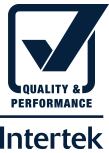Quality and Performance Mark FAQ
Intertek's Quality and Performance Mark is designed to give manufacturers a point of differentiation in the marketplace and consumers peace of mind about their product purchases. Below are some frequently asked questions about the Mark.

Q: My brand name is my ‘Quality & Performance Mark’, why should I spend even more money on implementation?
A: The Mark is not meant to replace all the effort you’ve put into building your brand. Instead think of the Mark as another tool you can use to build your brand, whether it’s:
- Differentiating your product at the point of purchase
- Proving to retail chain buyers that your product stands out from the competition
- Helping you through crucial points in a product’s adoption
- Independent verification which will lead consumers to the right choice: Your Product
Q: Will this slow down my time to market?
A: The facts of the matter are that any additional testing, which the Mark is, would slow down time to market. However, the additional time can be kept to a minimum in several ways:
- The Mark testing can be done in parallel with safety testing.
- Through utilizing Intertek’s worldwide network of testing labs; if one lab is not available testing can be potentially shared with another Center of Excellence.
- Working collaboratively with you to communicate timing and scheduling opportunities from the very beginning, at the quote stage.
- Style guide templates for mark labeling and promotion can be downloaded in advance.
Q: Will every product submitted receive the Mark?
A: No, testing for the Mark is designed to identify the top one-third to one-half of products in any given category. Intertek will conduct benchmark testing to see where requirements should be initially set, then review these benchmarked levels every 12 months; if needed, the bar will be raised to ensure that only top quality products will receive the Mark.
Q: What happens if my product fails testing for the Mark?
A: Intertek won’t just give you a failing test report. We will inform you of the product deficiencies and provide you with tools for improving it, which may include:
- AST (Accelerated Stress Testing) – a group of test methods that have a highly focused information goal, designed to obtain the information as quickly as possible
- Hypothesis Matrix – A tool used to identify all the hypotheses that must be true for a product to work, and identifying the necessary tests to prove them
- Failure Analysis - The mechanical, physical and chemical investigation into the root cause and sequence of events that leads to a product no longer meeting expectations
- Research Testing – Analysis & discovery of characteristics and features of new materials and new products
Once design improvements have been made, the product can be re-submitted for testing.
Q: Once the Mark is awarded how can it be used?
A: The mark can be applied to the full range of customer’s promotional efforts, including advertising, package labeling and point of purchase.
Q: How can consumers verify that a product is certified?
A: Intertek has an online product directory at www.IntertekCheck.com where consumers can conduct searches for certified products.